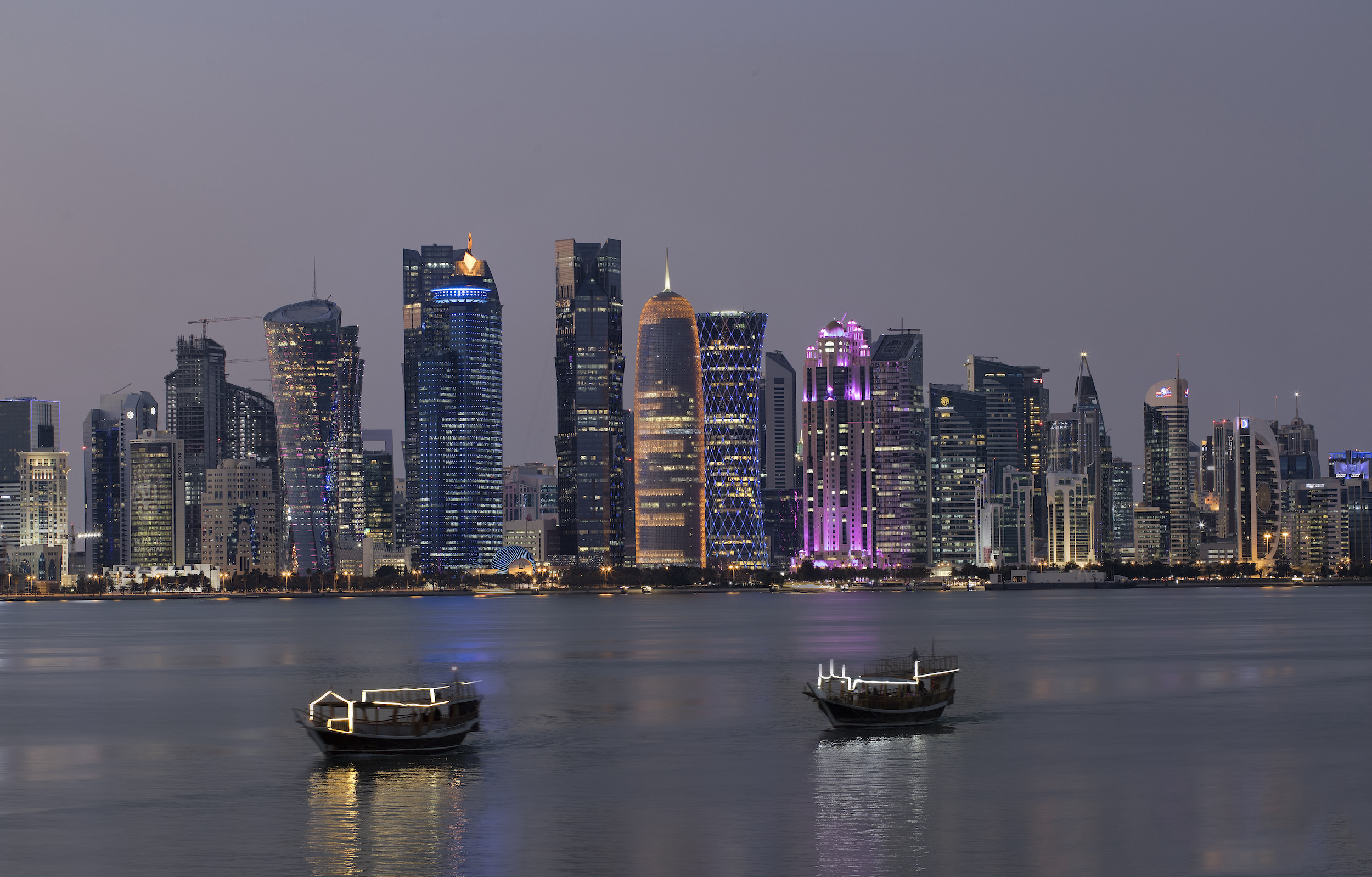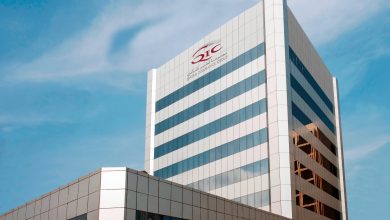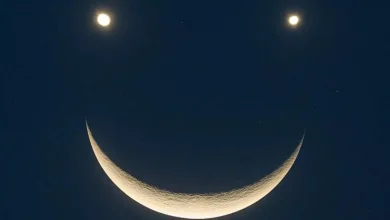Doha; jaw-dropping transformation over the past 50 years: Daily Mail
دايلي ميل: الدوحة.. تحول مذهل على مدار 50 عاماً
Fascinating photographs show how Qatar’s capital city has undergone an incredible transformation over the past 50 years.
Then and now pictures, courtesy of Qatar Tourism, illustrate how Doha’s landmarks and landscapes have changed dramatically over a period of time that amounts to a blink of an eye, historically.
For example, the Sheraton Grand Hotel was once the only building to mark the flat stretch of sand along the West Bay area. A glittering skyline of sci-fi-style skyscrapers has since sprouted by the water’s edge.
As this rapid development got underway, notable pieces of Qatari history – such as the Barzan Towers and the Al Zubarah Fort – were preserved and restored. And there’s more besides.
Qatar Airways Group Chief Executive and Chairman of Qatar Tourism, His Excellency Mr Akbar Al Baker, said: ‘Qatar has a fascinating history for such a small country, stretching back way into the annals of ancient human history. Yet no period has been as dramatic and transformational as the past 50 years, where huge infrastructure programmes have made modern Doha essentially unrecognisable from how it used to be.’
Scroll down to see the astonishing contrast between past and present…
WEST BAY SKYLINE:

The picture on the right, taken in the late 1970s, shows the Sheraton Grand Doha Resort and Convention Hotel in West Bay being constructed. Over the decades, a stunning transformation of the area took place. In contemporary Doha, the Sheraton stands among a forest of sci-fi skyscrapers.
SHERATON HOTEL:

Shaped like a pyramid and built on the shores of Doha Bay, The Sheraton opened on February 22, 1982. The hotel’s steel frame and prefabricated panels were new methods of construction in Qatar at the time.
NATIONAL MUSEUM OF QATAR (NMOQ):

The Old Palace of Sheikh Abdullah bin Jassim Al Thani is one of Doha’s most recognisable landmarks. The palace is now encased by the UFO-like National Museum of Qatar (NMoQ), which opened its doors as a museum in 2019. The museum was designed by French architect Jean Novel, who was inspired by the form and shape of a desert rose.
OLD SHEIKH’S PALACE:

To the right, you’ll see the historic palace of Sheikh Abdullah bin Jassim Al-Thani as it appeared in 1960. Known as ‘The Old Palace’, the grand building was constructed during the early 20th century. The palace, which once stood as the seat of government in Qatar, has been restored several times over the years.
TOWER IN AL BIDDA PARK:

The photograph on the right was taken around 1959, showing the tower on an old fort in Al Bidda Park. The tower was reconstructed as part of the restoration of the park, which is near Doha Bay.
DOHA POST OFFICE:

The main post office of Doha was constructed in 1979, and it’s still in operation today. The distinctive design of the roof helps to bring light into the space while keeping the building cool.
CENTRAL BANK:

The snapshot on the right dates back to the 1970s. Originally known as the Qatar Monetary Agency, the Qatar Central Bank HQ was established in 1973. Once it was founded, the bank issued a new currency called the Qatari Riyal, which is still the country’s official currency.
BARZAN TOWERS:

To the right, the Barzan Towers are seen circa 1959. The watchtowers were built in the late 19th century. At 16 metres (52.4ft) in height, their name was inspired by their stature – in Arabic, ‘barzan’ means ‘high place’. Bringing them back to their former glory, the towers underwent a restoration in 2003.
VIEW FROM GULF HOTEL:

On the right, you’ll see the view from the Gulf Hotel in the 1970s, after construction on the Sheraton Grand had been completed. In the decades that followed, the rise of skyscrapers on the horizon dramatically transformed the view. Large construction projects and new beaches have also altered the vista.
AL KAHRABA STREET:

Al Kahraba street in the Msheireb area of central Doha has been transformed as part of the Msheireb Downtown Doha programme, which is ‘the world’s first sustainable downtown regeneration project’. The project is reviving the old commercial district with contemporary Qatari architecture.

Al Kahraba street was the first street in Qatar to be fully lit. Its name derives from this fact – ‘kahraba’ means electricity in Arabic. The photograph on the left was captured in 2021. Al Kahraba street, and the surrounding area, are now home to luxury townhouses, premium apartments, hotels, museums, and offices. According to Qatar Tourism, the area ‘blends Qatari heritage and aesthetics with modern technology’.
SOUQ WAQIF:

Cast your eye to the right and you’ll see the traditional Souq Waqif marketplace in the 1970s. Fast forward to the modern-day and the Souq Waqif remains an important part of daily life in Doha. Thanks to its central location in the city, the souq attracts locals and tourists alike.

The Souq Waqif is built on the site of Doha’s century-old trading market, near the waterside. In the 70s, the marketplace had space for visiting vehicles to park alongside the shops. Today, however, most drivers park in the area’s underground car park.

The Souq Waqif fell into decline near the end of the 20th century. Further destruction occurred in 2003 when a fire ravaged most of the marketplace. In the years that followed, plans were put in place to restore the Souq Waqif to its original historical appearance, and this restoration was finally completed in 2008. The Qatar Tourism board says the restoration ‘has been an incredible success and it [the Souq Waqif] has become one of Doha’s most popular sites’.
AL ZUBARAH FORT:

The image on the right was captured in the 1950s and shows the Al Zubarah Fort, which is the most prominent feature of the Unesco-listed Al Zubarah Archaeological Site. It’s also the youngest feature, having been built in 1938. The Al Zubarah Fort, which has been described as a ‘pristine’ example of a typical Arab fort, features one-metre-thick (3.2ft) walls, which helped to ward off invaders and keep rooms cool throughout the sweltering heat of the summer.
DUKHAN AIRPORT:

Pictured on the right is the old Dukhan Airport control tower, which was constructed in the 1930s. It was located in Qatar’s first-ever airport, which was made obsolete by the grand opening of the Doha International Airport in 1959. On the left, you’ll see that the original Dukhan Airport was recently restored.
OXYGEN PARK:

The photograph on the right was taken in the early 2010s, when Doha’s Oxygen park was under construction. Sidra Hospital, designed by renowned Argentine-American architect Cesar Pelli, can be seen in the background. The park was inaugurated in 2019. It is based in Education City, the city’s university and learning centre. According to Qatar Tourism, the park has become a ‘green lung’ for the students of the surrounding educational facilities and campuses
الشرق
الدوحة: نشرت صحيفة ديلي ميل Daily Mail البريطانية تقريراً يسلط الضوء على قطر ما بين الماضي والحاضر والتحول المذهل في معالم قطر والمناظر الطبيعية على مدار خمسين عاماً مستشهداً بصور توضح ذلك.
وأشار التقرير إلى التغير في معالم قطر واضح بشكل كبير على مدار خمسين عاماً، وعلى الرغم من التطور السريع إلا أن قطر حافظت على أجزاء بارزة من التاريخ والتراث القطري مثل أبراج برزان وقلعة الزبارة.
وقال سعادة السيد أكبر الباكر، الرئيس التنفيذي لمجموعة الخطوط الجوية القطرية، رئيس جهاز قطر للسياحة: “على الرغم من صغر مساحة قطر إلا أنها تمتلك تاريخاً رائعاً يمتد إلى سجلات التاريخ البشري القديم. وأضاف: “لم تمر قطر بمرحلة تحويلية مثل الخمسين عاماً الماضية، حيث جعلت برامج البنية التحتية الضخمة من الدوحة الحديثة تختلف كلياً عما كانت عليه من قبل.”
وذكر التقرير عدداً من الأماكن في قطر مستشهداً بصور توضح التغيرات الكبيرة بين الماضي والحاضر ومنها:
الخليج الغربي:

التقطت الصورة على اليمين في أواخر السبعينيات لمنتجع شيراتون الدوحة وهو قيد الإنشاء، وعلى مر العقود حدث تطور مذهل في المنطقة ليصبح فندق شيراتون الدوحة اليوم وسط غابة من ناطحات السحاب.

وبُني فندق الشيراتون على شكل هرم على شاطئ خليج الدوحة، وتم افتتاحه في 22 فبراير 1982.
متحف قطر الوطني:

يعد القصر القديم للشيخ عبد الله بن جاسم آل ثاني أحد المعالم الأكثر شهرة في الدوحة. ويحاط القصر الآن بمتحف قطر الوطني، والذي افتتح أبوابه كمتحف في عام 2019. وصمم المتحف المهندس المعماري الفرنسي جان نوفيل، مستوحياً شكل التصميم من وردة الصحراء.
القصر التاريخي للشيخ عبدالله بن جاسم آل ثاني:

تُظهر الصورة على اليمين القصر التاريخي للشيخ عبدالله بن جاسم آل ثاني عام 1960، والمعروف بالقصر القديم. وتم ترميم المبنى والذي كان مقراً للحكومة في قطر أكثر من مرة ليظهر كما في الصورة على اليسار.
برج البدع:

التقطت الصورة على الجانب الأيمن عام 1959 لبرج البدع على حصن قديم، وأعيد بناؤه من جديد كجزء من ترميم حديقة البدع التي تقع بالقرب من خليج الدوحة كما تظهر الصورة على اليسار.
مكتب بريد الدوحة:

تم إنشاء مكتب بريد الدوحة الرئيسي في عام 1979، ولا يزال يعمل حتى اليوم. ويساعد التصميم المميز للسقف على إضفاء الضوء على المساحة مع الحفاظ على برودة المبنى.
مصرف قطر المركزي:

تعود اللقطة الأولى إلى السبعينيات للبنك المركزي والذي كان يُعرف باسم مؤسسة النقد القطرية. تأسس المقر الرئيسي لمصرف قطر المركزي في عام 1973. وبمجرد تأسيسه، أصدر البنك عملة جديدة تسمى الريال القطري، والتي لا تزال العملة الرسمية للبلاد.
أبراج برزان:

تظهر الصورة على اليمين أبراج برزان عام 1959، وتم بناؤها في أواخر القرن التاسع عشر كأبراج مراقبة. وبنيت الأبراج على ارتفاع 16 متراً مستوحية الاسم من معناها باللغة العربية، حيث تعني كلمة برزان المكان المرتفع. وتم ترميم الأبراج عام 2003.
إطلالة فندق الخليج:

تعرض الصورة على اليمين إطلالة فندق الخليج في السبعينات بعد الانتهاء من تشييد فندق شيراتون جراند. وتُظهر الصورة على اليسار ناطحات السحاب في الأفق والتغيير الجذري للمشهد.
شارع الكهرباء:

تظهر الصورة على اليمين شارع الكهرباء قديماً وهو أول شارع في قطر يضاء بالكامل بالكهرباء. وأصبح الشارع الآن في منطقة مشيرب قلب الدوحة وهو أول مشروع مستدام لتجديد وسط الدوحة. وأعاد إحياء المشروع الحي التجاري القديم بهندسة معمارية قطرية معاصرة.

وأصبح شارع الكهرباء الآن محاطا بمنطقة فيها منازل فاخرة وفنادق ومتاحف في مشيرب والتي تمزج ما بين التراث القطري والجمال والتكنولوجيا الحديثة.
سوق واقف:

تظهر الصورة على اليمين سوق واقف في فترة السبعينات، الذي لايزال جزءاً مهماً من الحياة اليومية في الدوحة بفضل موقعه المركزي في المدينة جاذباً السياح والسكان المحليين على حدٍ سواء.

وتم بناء سوق واقف في موقع سوق التجارة في الدوحة الذي يعود تاريخه إلى قرن من الزمان. في السبعينيات، كان السوق يحتوي على مساحة لركن المركبات بجانب المحلات لكن اليوم أصبح ركن السيارات في موقف للسيارات تحت الأرض.

في عام 2003 دمر حريق كبير معظم السوق، وتم وضع خطط لإعادة سوق واقف إلى شكله التاريخي وتم الانتهاء من الترميم عام 2008.
قلعة الزبارة:

التقطت الصورة على اليمين لقلعة الزبارة في الخمسينيات من القرن الماضي، وهي أحد أبرز المعالم المدرجة في قائمة اليونسكو لمواقع التراث العالمي. تم بناؤها عام 1938 كنموذج مثالي للقلعة العربية. ويبلغ سمك الجدران فيها متراً واحداً للحماية من الغزاة والحفاظ على برودتها من الداخل في فصل الصيف.
مطار دخان:

تظهر الصورة على اليمين برج مراقبة مطار دخان القديم والذي تم بناؤها في ثلاثينيات القرن الماضي كأول مطار قطري، وتم ترميمه مؤخراً.
حديقة الأكسجين:

التقطت الصورة على اليمين عام 2010 عندما كانت حديقة الأكسجين قيد الإنشاء، وتم افتتاح الحديقة عام 2019 في المدينة التعليمية.




